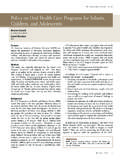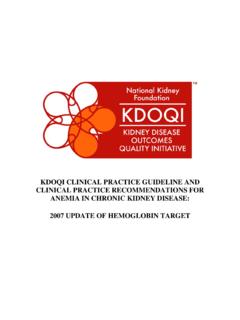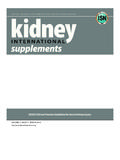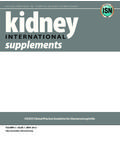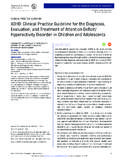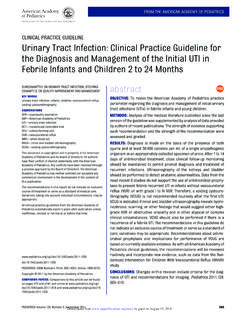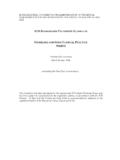Transcription of Evidence-based Clinical Practice Guideline for the …
1 AMERICAN ACADEMY OF PEDIATRIC DENTISTRYCLINICAL Practice Guideline EPit-and-fissure sealants have been used for nearly 5 decades to prevent and control carious lesions on primary and permanent teeth. Sealants are still underused despite their documented effi- cacy and the availability of Clinical Practice ,2 New sealant materials and techniques continue to emerge for man- aging pit-and-fissure caries, further complicating the clinician s decision making. Accordingly, continuous critical review of the available evidence is necessary to update Evidence-based recom- mendations and assist health care providers in Clinical decision ,7 The American Dental Association (ADA) Council on Scien- tific Affairs convened an expert panel to develop the previous Evidence-based Clinical recommendations for the use of sealants, published in In an effort to update the 2008 recom- mendations, the ADA Council on Scientific Affairs and the ADA Center for Evidence-based Dentistry, in collaboration with the American Academy of Pediatric Dentistry (AAPD)
2 , convened a new working group including Clinical experts, stakeholders, and methodologists to develop a systematic review8 and accompa- nying Evidence-based Clinical Practice recommendations for publication in Clinical Practice Guideline for the Use of Pit-and-Fissure SealantsDeveloped and Endorsed by American Academy of Pediatric Dentistry and American Dental AssociationAdopted 2016 ABBREVIATIONS AAPD: American Academy of Pediatric Dentistry. ADA: American Dental Association. BPA: Bisphenol A. GI: Glass ionomer. GRADE: Grading of Recommendations Assessment, Development and Evaluation. NHANES: National Health and Nutrition Examination Survey. CIs: Confidence : This article presents Evidence-based Clinical recommendations for the use of pit-and-fissure sealants on the occlusal surfaces of primary and permanent molars in children and adolescents. A Guideline panel convened by the American Dental Association (ADA) Council on Scientific Affairs and the American Academy of Pediatric Dentistry conducted a systematic review and formulated recommendations to address Clinical questions in relation to the efficacy, retention, and potential side effects of sealants to prevent dental caries; their efficacy compared with fluoride varnishes; and a head-to-head comparison of the different types of sealant material used to prevent caries on pits- and-fissures of occlusal of studies reviewed: This is an update of the ADA 2008 recommendations on the use of pit-and-fissure sealants on the occlusal surfaces of primary and permanent molars.
3 The authors conducted a systematic search in MEDLINE, Embase, Cochrane Central Register of Controlled Trials, and other sources to identify randomized controlled trials reporting on the effect of sealants (available on the market) when applied to the occlusal surfaces of primary and permanent molars. The authors used the Grading of Recommendations Assessment, Develop- ment, and Evaluation approach to assess the quality of the evidence and to move from the evidence to the : The Guideline panel formulated 3 main recommendations. They concluded that sealants are effective in preventing and arresting pit-and-fissure occlusal carious lesions of primary and permanent molars in children and adolescents compared with the nonuse of sealants or use of fluoride varnishes. They also concluded that sealants could minimize the progression of non-cavitated occlusal carious lesions (also referred to as initial lesions) that receive a sealant. Finally, based on the available limited evidence , the panel was unable to provide specific recommendations on the relative merits of 1 type of sealant material over the and practical implications: These recommendations are designed to inform practitioners during the Clinical decision-making process in relation to the prevention of occlusal carious lesions in children and adolescents.
4 Clinicians are encouraged to discuss the information in this Guideline with patients or the parents of patients. The authors recommend that clinicians re-orient their efforts toward increasing the use of sealants on the occlusal surfaces of primary and permanent molars in children and : PIT-AND-FISSURE SEALANTS, Clinical RECOMMENDATIONS, Guideline , OCCLUSAL CARIES, CARIES PREVENTION, CARIES ARRESTING To cite: Wright JT, Crall JJ, Fontana M, et al. Evidence-based Clinical Practice Guideline for the Use of Pit-and-Fissure Sealants. American Academy of Pediatric Dentistry, American Dental Association. Pediatr Dent 2016;38(5) Practice Guideline 263264 Clinical Practice GUIDELINEAmemAmrimcanr ndcccccycofcPcrtcDcccccsDcPcslOur goal for this 2016 Clinical Practice Guideline was to provide clinicians with updated Evidence-based recommenda- tions regarding when and how the placement of pit-and-fissure sealants is most likely to be effective in preventing carious lesions on the occlusal surfaces of primary and permanent teeth in children and adolescents.
5 The target audience for this Guideline includes general and pediatric dental practitioners and their sup- port teams, public health dentists, dental hygienists, pediatricians, primary-care physicians, and community dental health coordi- nators; policy makers may also benefit from this Guideline to inform Clinical decision making, programmatic decisions, and public health of Dental CariesDental caries is a disease caused by an ecological shift in the composition and activity of the bacterial biofilm when exposed over time to fermentable carbohydrates, leading to a break in the balance between demineralization and Carious lesions are preventable by averting onset, and manage- able by implementing interventions, which may halt progression from early stage of the disease to cavitation, characterized by enamel demineralization, to frank In 2015, the ADA published the Caries Classification System, which defines a non- cavitated or initial lesion as initial caries lesion development, before cavitation occurs.
6 Noncavitated lesions are characterized by a change in color, glossiness, or surface structure as a result of demineralization before there is macroscopic breakdown in surface tooth structure. 4 EpidemiologyNational Health and Nutrition Examination Survey (NHANES) 2011-20125 data show that 21% of children aged 6 to 11 years and 58% of adolescents aged 12 to 19 years had experienced carious lesions (untreated and treated [restored]) in their perma- nent NHANES report also found the prevalence of carious lesions in permanent teeth increased with age and differed among sociodemographic groups. Children in the 9- to 11-year range had higher carious lesion prevalence (29%) compared with chil- dren in the 6- to 8-year range (14%). Similarly, children in the 16- to 19-year age range had higher carious lesion prevalence (67%) compared with children in the 12- to 15-year range (50%).
7 In addition, dental caries incidence for both 6- to 11- year and 12- to 19-year age groups was highest among Hispanic children compared with non-Hispanic black children, non- Hispanic white children, and Asian children. The surgeon general s report on oral health similarly indicated that Hispanic and non- Hispanic black children are at the highest risk of developing dental Overall, NHANES 2011-2012 indicates a higher prevalence of untreated carious lesions in the 12- to 19-year age group (15%) compared with the 6- to 11-year age group (6%).5 Although there has been a decline in prevalence of caries in adolescents and children in particular, the decrease in occlusal surface caries has not kept pace with the decrease in the smooth surface Although this overall decline has been attributed to preventive interventions such as water fluoridation, fluoride tooth-paste, fluoride varnishes, and sealants, topical fluoride applications such as fluoride varnishes may have a greater effect reducing carious lesions on smooth surfaces compared with caries in pits and ,9,10 NHANES 2011-2012 data show that 41% of children aged 9 to 11 years and 43% of adolescents aged 12 to 19 years had at least 1 dental sealant.
8 Non-Hispanic black children had the lowest dental sealant prevalence in both age groups compared with Hispanic, non-Hispanic white, and Asian There- fore, underutilization of sealants is of key Role of Pit-and-Fissure Sealants in Primary and Secondary PreventionFrom a primary prevention perspective, anatomic grooves or pits and fissures on occlusal surfaces of permanent molars trap food debris and promote the presence of bacterial biofilm, thereby increasing the risk of developing carious lesions. Effectively pene- trating and sealing these surfaces with a dental material for example, pit-and-fissure sealants can prevent lesions and is part of a comprehensive caries management a secondary prevention perspective, there is evidence that sealants also can inhibit the progression of noncavitated carious The use of sealants to arrest or inhibit the pro- gression of carious lesions is important to the clinician when determining the appropriate intervention for noncavitated carious Materials and Placement TechniquesFor the purposes of this report, there are 4 sealant materials under a classification proposed by Anusavice and colleagues11: resin- based sealants, glass ionomer (GI) cements, GI sealants, polyacid-modified resin sealants, and resin-modified GI sealants.
9 They defined the materials as Resin- based sealants are urethane dimethacrylate, UDMA, or bisphenol A-glycidyl methacrylate (also known as bis- GMA ) monomers polymerized by either a chemical acti- vator and initiator or light of a specific wavelength and intensity. Resin- based sealants come as unfilled, colorless, or tinted transparent materials or as filled, opaque, tooth- colored, or white materials. GI sealants are cements that were developed and are used for their fluoride-release properties, stemming from the acid- base reaction between a fluoroaluminosilicate glass powder and an aqueous- based polyacrylic acid solution. Polyacid-modified resin sealants, also referred to as compo- mers, combine resin- based material found in traditional resin- based sealants with the fluoride-releasing and adhesive properties of GI sealants. Resin-modified GI sealants are essentially GI sealants with resin components.
10 This type of sealant has similar fluoride- release properties as GI, but it has a longer working time and less water sensitivity than do traditional GI sealants. AMERICAN ACADEMY OF PEDIATRIC DENTISTRYCLINICAL Practice Guideline EPlacement techniques for pit-and-fissure sealants vary based on sealant type and the manufacturer or Manufacturers instructions usually detail cleaning and isolation of the occlusal surface and encourage a dry environment during sealant place- ment and curing. Acid etching of occlusal surfaces is required before resin- based sealant placement. Other techniques men- tioned in the studies included in the 2008 report are the use of bonding agents or adhesives, as well as mechanical preparations such as air abrasion or questions regarding pit-and-fissures sealantsTo assist clinicians in the use of pit-and-fissure sealants in occlusal surfaces of primary and permanent molars, the guide- line panel developed the following Clinical questions: Should dental sealants, when compared with nonuse of sealants, be used in pits and fissures of occlusal surfaces of primary and permanent molars on teeth deemed to have clin- ically sound occlusal surfaces or noncavitated carious lesions?





